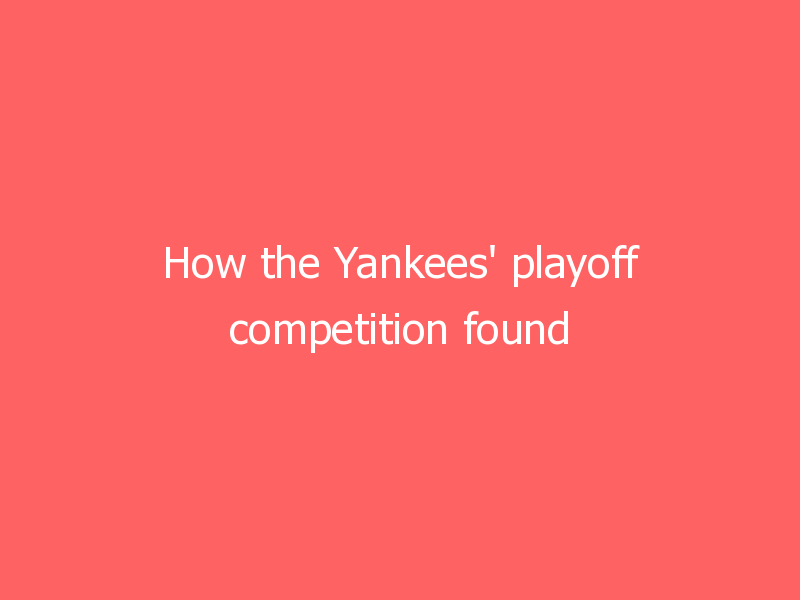How the Yankees’ playoff competition found themselves in the hunt, Part 1
The home stretch is upon us! With just over 50 games remaining in the regular season (wow, that really puts into perspective just how short the 2020 one was), the playoff hunt has begun to take shape, and the contenders and the pretenders have begun to split off from the rest of the pack. As we begin to fervently scoreboard watch, it’s time that we take a step back, and see how the Yankees‘ competition for the Wild Card or, fingers crossed, the American League East division found their way into the playoff hunt.
For the purposes of this exercise, we have narrowed down the list of teams relevant to the Yankees to the Seattle Mariners, Oakland Athletics, Houston Astros, Boston Red Sox, Toronto Blue Jays, and Tampa Bay Rays; due to the wide disparity between the Chicago White Sox and literally every other team in their division — they lead the Cleveland Guardians-To-Be by more than nine games — they have very little effect on the Wild Card hunt beyond, “Please lose to us and beat our opponents,” and so can be safely left out of this discussion, at least for the time being.
This is the first part of a two-part article, the latter of which will be posted later today. Here, we will profile the three teams outside the division that the Yankees will compete against for one of the two Wild Card spots: the Seattle Mariners, the Oakland Athletics, and the Houston Astros.
Seattle Mariners
If you wanted to sum up the Seattle Mariners’ season in one word, the word that I would choose is, “paradox.” As we discussed in our first-ever PSA Pregame on Twitter Spaces this past Thursday, the Mariners should not be in the thick of the playoff hunt: whether you look at their Pythagorean record, which uses run differential to predict what your record should be, or BaseRuns, a FanGraphs metric that tries to predict run differential based on your team’s batted ball profile, the Mariners have won eight-nine games more than they should have. In other words, they ought to be in fourth place in their division, well behind the 55-54 Los Angeles Angels, not fighting for a Wild Card spot.
And yet, there they are, right in the thick of it. How, you might ask? Surely not on the back of their offense, which has posted a well-below-average 93 wRC+ and has accrued only 8.3 fWAR, eighth-worst in baseball. Their starting rotation has also been atrocious — their 4.80 ERA is eighth-highest in the league, and their FIP (4.68) and xFIP (4.57) are only slightly better; outside Yusei Kikuchi and Chris Flexen, there’s not a starter I would even begin to think about possibly worrying about as an opponent. If they ever had one strength, it would be their bullpen, whose 4.6 fWAR is bested only by the Yankees’ (4.9) and Rays’ (5.8). Unfortunately for Seattle, I have to say “had” and not “has,” because one of their most important pieces, Kendall Graveman, is now a member of the Houston Astros, and while they still have some good pieces in the bullpen, losing a lights-out closer with a sub-one ERA is always a serious blow.
The 2021 Mariners are, in a lot of ways, the product of luck: their record in one-run games is 23-12, best in the league, and while there is a certain skill to winning one-run games (mostly attributed to the bullpen’s ability to hold a one-run lead), a large component of a team’s one-run record comes down simply to luck. Taking all this into consideration, the Mariners are just as likely to melt in the heat of August as any among the Yankees’ playoff rivals.
Oakland Athletics
In what has seemingly become a year-in, year-out tradition (with the notable exception of the 2020 season), the Oakland Athletics are in the midst of a fantastic season, but look more primed to fight for a Wild Card berth than the AL West divisional title due to the performance of other teams in their division — after all, they won 97 games in 2019 but still finished 10 games out in the West.
The mantra of the 2021 A’s has been very simple: an elite pitching staff, which is tied for best in the American League with 3.91 runs/game, supports an offense that has been exactly league average. Sean Manaea, Chris Bassitt — who is quietly becoming one of the best starting pitchers in baseball — and Cole Irvin give Oakland one of the best front-three in the league, while former Yankees farmhand James Kaprielian has reminded everybody why he was once considered a top prospect so long as he could stay healthy. Perhaps unsurprisingly, however, he has been on the 10-day IL, although reports say he should be activated today.
Thanks in part to a down year at the plate by third baseman Matt Chapman — his OPS+ is down to 89 from his 120 career average — the Athletics have not given their top-flight pitching staff much run support: at 4.35 runs/game, they rank ninth-best in the AL. The deadline addition of Starling Marte was supposed to help them by shifting Ramon Laureano to right field and putting Stephen Piscotty’s 72 OPS+ squarely on the bench. A wrench was thrown into those plans this week, however, when Laureano received an 80-game suspension after testing positive for Nandrolone, thus violating the league’s PED policy.
Houston Astros
You may be wondering why the AL West-leading Astros are listed here — after all, their 65-45 record is second only to the Rays in the American League, their 69-40 Pythagorean record is second only to the Dodgers in all of baseball, and their 67-42 BaseRuns record trails only the Dodgers and the Giants. It’s simple, really: despite playing baseball at a higher level than their divisional rivals, the Astros are only three games ahead of the Athletics in their division; if the Astros stumble — and they have been of late, having gone 1-5 since the trade deadline — and the A’s or Mariners can put together a winning streak, the Astros could find themselves looking up in the division for the second straight year.
Even so, the Astros are a very good team. Their lineup is verily one of the best in the league, with six players posting an OPS+ of 130 or more when everyone is healthy, and they lead the league in teamwide wRC+ (118) and fWAR (23.7). I doubt any of them will receive any serious consideration for any kind of hardware — even without 2017 hanging over their heads, you can make the case that none of them is the best player at their position — but when you’ve got the depth that Houston has, runs will score.
If they have a weakness, it’s their pitching staff. Although they’ve put up strong numbers across the board, the Astros have been significantly overperforming on the mound: the starting rotation currently has an ERA (3.60) almost half a run lower than its FIP (4.08), and they rank in the middle third of the league in both FIP and fWAR (8.5). Additionally, the bullpen has been the team’s weakest link for much of the season (3.98 ERA, 4.28 FIP), although they did attempt to address it by bringing in Kendall Graveman and Yimi Garcia.
Originally found on Read More



![[VIDEO] Meghan McCain Just Can’t Stop Blasting Biden Lately…](https://manateeherald.com/wp-content/uploads/2021/06/300-4IokkF.jpeg)




